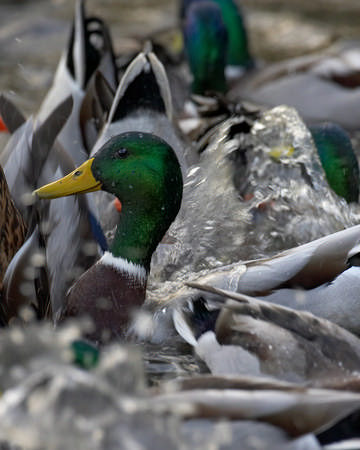
Mallard © Richard Steel
In contrast to the burgeoning breeding population, wintering numbers of Mallard have been dropping since the late 1970s (Banks et al 2006), apparently because of a decrease in immigration from continental Europe. Our breeding Mallard are quite sedentary, with a median distance of movement of 22 km (Migration Atlas). A few birds fly to continental Europe, including a chick ringed at Frodsham in 1968, shot in the Netherlands in winter 1979/ 80: almost all of the emigrants are males. Birds have come here especially from Finland and southern Sweden, with smaller numbers from all other countries from Russia to France. The proportion of immigrants in the British wintering population has declined greatly, from 50 - 60% in the 1950s and 1960s and 40% in the 1970s to only about 15% in the 1990s (Migration Atlas).
WeBS counts show that Mallards are widely distributed across many sites, such that only at the Ouse Washes do the numbers exceed 1% of the British total of 350,000 birds and thus qualify as nationally important for the species. The picture in Cheshire and Wirral has clearly changed in the last forty years, particularly at Rostherne Mere. Coward (1910) noted that on Rostherne, one of the deepest and latest to freeze of the meres, there were often thousands of Mallards when the shallow and more exposed waters were frost-bound. In the first volume summarising national counts of wildfowl (Atkinson-Willes 1963), numbers of Mallard at Rostherne Mere were ‘larger than on any inland water in England’, with peak totals of 4,000 in the early 1960s. At that time, Combermere and Doddington were the county’s next most important sites with counts of 600 and 410 in January 1966 (Bell 1967).
Nowadays the picture is very different. The largest wintering numbers are on the estuaries, with the highest WeBS counts during the three winters of this Atlas of 1,117 on the Dee (including sites outside Cheshire and Wirral) and 883 on the Mersey. Other sites with peak monthly counts in winter exceeding 300, as listed in the Cheshire and Wirral Bird Reports, were Chelford SQs with 885, Hurleston with 367 and the Sandbach Flashes with 315. The largest individual tetrad counts were 476 at Doddington (SJ74D) on a WeBS count in 2004/ 05 and 450 in the Gowy flood-plain (SJ47G) in 2004/ 05. Sadly, 206 birds was the maximum at Rostherne, in December 2006, about one-twentieth of the figure 45 years previously.
The Atlas map shows Mallards present in winter in 624 tetrads compared to 635 in breeding season. Birds were recorded in most estuarine tetrads, in the shallow waters close to shore, but quit 40 in which they were present during the breeding season. They withdrew from some of the highest eastern tetrads. All of the freshwater habitats were occupied in similar proportions to the breeding season, but with a small shift away from the ponds and smaller standing waters to lakes and rivers, and 32 estuarine/ saltmarsh tetrads. Even in the winter flocks, many birds have one eye on the coming breeding season and they seem to keep more or less in pairs, the male following the female closely. Mallards shift to a more vegetarian diet during winter but take a very wide variety of foods. On water they dabble, upend and occasionally dive in shallow water for seeds and invertebrates. Provided that they feel safe enough, some will feed well away from water, on stubble and other agricultural waste, fruit and of course the inevitable offers of bread from the great British public.
Sponsored by Mark Greenhough

